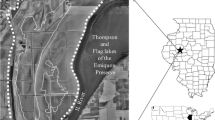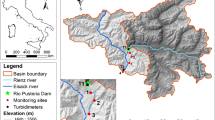Abstract
We examined the response of aquatic macroin vertebrates to three marsh management strategies. The three management practices compared were conventional full pool management, full pool management with carp(Cyprinus carpio) control, and controur furrowing (also with carp control). Significant differences in standing crops (both numbers and biomass) of invertebrates were observed among the three management strategies. The contour furrowed area had the highest standing crops of water column invertebrates, followed by the carp-controlled full pool area, while the conventionally managed area had the lowest standing crops. In the benthos, the two full pool areas (with and without carp) had higher standing crops than the contour furrowed area. Significant differences were noted in seasonal abundance, with all management practices having lowest densities of invertebrates in April and May. Implications for management include indications of the negative impacts of carp and winter drawdowns on invertebrates in managed marshes.
Similar content being viewed by others
Literature Cited
Berry, C. B. 1982. Behavior and ecology of carp in the Bear River Migratory Bird Refuge. Utah Cooperative Fishery Research Unit. Utah State University, Logan, UT, USA.
Danell, K. and K. Sjoberg. 1977. Seasonal emergence of chironomids in relation to egg laying and hatching of ducks in a restored lake (northern Sweden). Wildfowl 28: 129–135.
Edmondson, W. T. and G. C. Winberg. 1971. A manual on methodsfor the assessment of secondary production in fresh waters. IBP Handbook No. 17. Blackwell Scientific Pub. Oxford, England.
Elliott, J. M. 1973. Some methods for the statistical analysis of samples of benthic invertebrates. Freshwater Biological Association Scientific Publication 49.
Hurlbert, S. H. 1984. Pseudoreplication and the design of ecological field experiments. Ecology 54: 187–211.
Kadlec, J. A. 1962. Effects of Drawdown on a Waterfowl Impoundment. Ecology 43:267–281.
Kadlec, J. A. and L. M. Smith. 1984. Marsh plant establishment on newly flooded salt flats. Wildlife Society Bulletin 12:388–394.
Kaminski, R. M. and H. R. Murkin. 1981. Evaluation of two devices for sampling nektonic invertebrates. Journal of Wildlife Management 45:493–496.
Kaminski, R. M. and H. H. Prince. 1981. Dabbling duck activity and foraging responses to aquatic macroinvertebrates. Auk 98: 115–126.
Krull, J. N. 1969. Seasonal occurrence of macroinvertebrates in a green-tree reservoir. N. Y. Fish and Game Journal 16: 119–124.
Krull, J. N. 1970. Aquatic plant macroinvertebrate associations and waterfowl. Journal of Wildlife Management 34: 707–718.
Maclachlan, A. J. 1974. Recovery of mud and fauna in a tropical lake. Limnology and Oceanography 19:74–83.
Murkin, H. R. 1983. Responses by aquatic invertebrates to prolonged flooding of marsh habitat. Ph. D. Dissertation. Utah State University. Logan, UT, USA.
Murkin, H. R. and J. A. Kadlec. 1986. Relationships between waterfowl and macroinvertebrate densities in a northern prairie marsh. Journal of Wildlife Management 50:212–217.
Pennak, R. W. 1978. Freshwater invertebrates of the United States. 2nd ed. J. Wiley & Sons. Inc. New York, NY, USA.
Robel, R. 1961. The effects of carp populations on the production of waterfowl plant foods on a western waterfowl marsh. Transactions of the North American Wildlife Conference 26: 147–159.
Shroeder. L. D. 1973. A literature review on the role of invertebrates in waterfowl management. Colorado Division of Wildlife Special Report 29.
Swanson, G. A. 1978. A simple lightweight core sampler for quantitating waterfowl foods. Journal of Wildlife Management 42:426–429.
Swanson, G. A. and M. I. Meyer. 1973. The role of invertebrates in the feeding ecology of Anatinae during the breeding season. p. 143–185.In Waterfowl Habitat Management Symposium. Monction, NB, Canada.
Voights, D. K. 1976. Aquatic invertebrate abundance in relation to changing marsh vegetation. American Midland Naturalist 95: 313–322.
Weier, J. L. and D. R. Starr. 1950. The use of rotenone to remove rough fish for the purpose of improving waterfowl refuge areas. Journal Wildlife Management 14:203–205.
Whitman, W. R. 1976. Impoundments for waterfowl. Canadian Wildlife Service Occasional Paper No. 22.
Author information
Authors and Affiliations
Rights and permissions
About this article
Cite this article
Huener, J.D., Kadlec, J.A. Macroinvertebrate response to marsh management strategies in Utah. Wetlands 12, 72–78 (1992). https://doi.org/10.1007/BF03160588
Received:
Accepted:
Issue Date:
DOI: https://doi.org/10.1007/BF03160588




